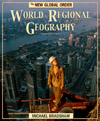

 World Regional Geography: The New Global Order Update, 2/e Our World and Geography Chapter ObjectivesAfter reading and studying this chapter you should be able to:
|
 2002 McGraw-Hill Higher Education
2002 McGraw-Hill Higher EducationAny use is subject to the Terms of Use and Privacy Policy.
McGraw-Hill Higher Education is one of the many fine businesses of The McGraw-Hill Companies.